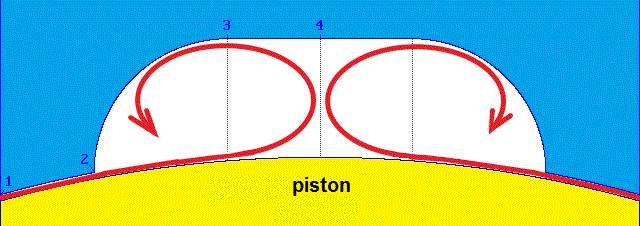Institute of TwoStrokes a écrit:
Frits are you happy to explain about after the exhaust port closing? Torroidal heads, turbulent eddies spin rates etc etc?
Frits Overmars:
I would be happy to explain about a lot of things. But I work 24/7 and the rest of the time I sleep, so there is not much time left to do some explaining.
Combustion in an ideal homogeneous air/fuel-mixture has a flame speed of maybe 2 meters per second. So how is it possible that combustion in a 125 cc engine, running at 13000 rpm, is completed within 50 degrees of crankshaft revolution?
The answer is turbulence. Burning lumps of mixture are blown across the combustion chamber and then simultaneously start their own fires in every corner. The blowing is taken care of by the squish effect that pinches mixture (red on the drawing below) from between the piston (yellow) and the outer area of the cylinder head (blue).
There are programs that calculate the squish velocity, and they are all ********. Why? Because none of these programs take into account that at high rpm the crankshaft bends, the conrod stretches and the piston moves higher by about 1 % of the crankshaft stroke. And it makes a
lot of difference for the squish velocity, whether the minimum distance between piston and head is 0,6 mm or 0,06 mm...
The higher the flame speed, the better is is for power and for the thermal load on the engine. So make your squish gap as narrow as possible: 1 % of the stroke. And do not be afraid that the slightly higher compression ratio will cause detonation; effective squish will do just the opposite.
In days of old the ideal combustion chamber was considered to be a sphere with the spark plug in the center, so that the flame path was as short as possible in all directions. And because that was impractial, the next best thing was a semi-sphere. But that is ancient history; we need turbulence!
Toroidal cylinder heads are shaped so that the inital turbulence, created by the scavenging streams of fresh mixture and still present in the cylinder after the transfer ports have closed, is enhanced as the squish effect moves the mixture towards the spark plug. And after that, the toroidal turbulence takes burning lumps of mixtures from the plug area towards all corners of the combustion chamber.






